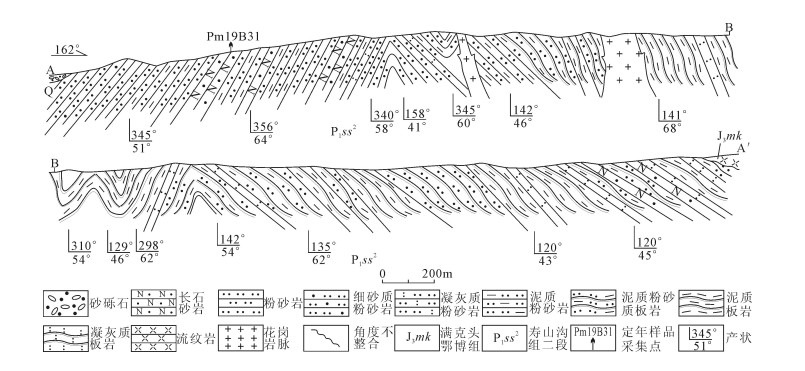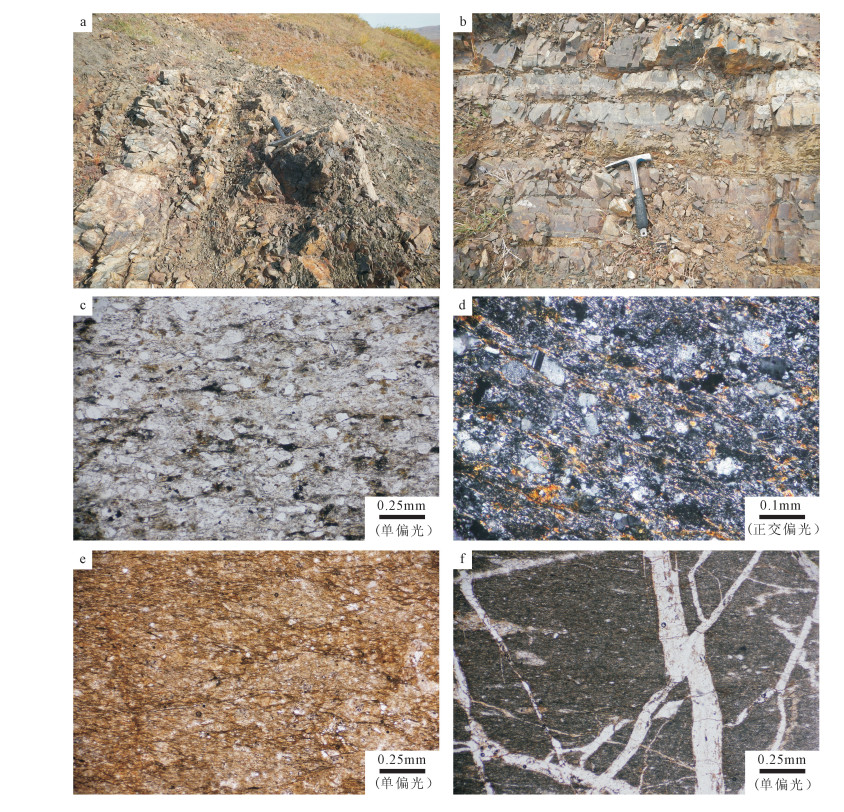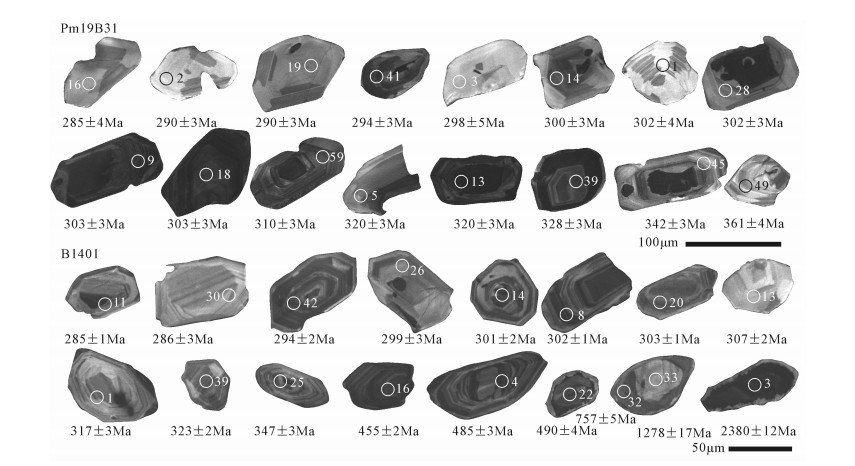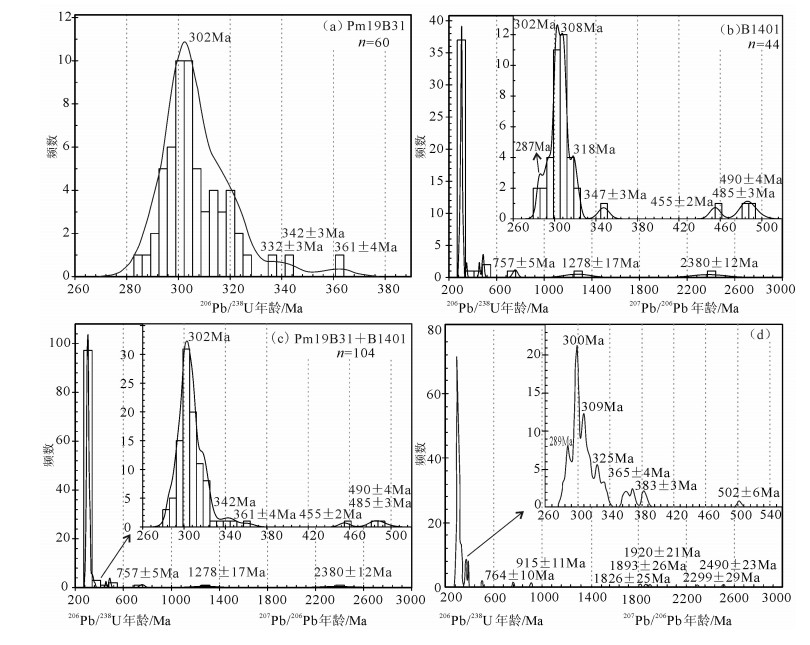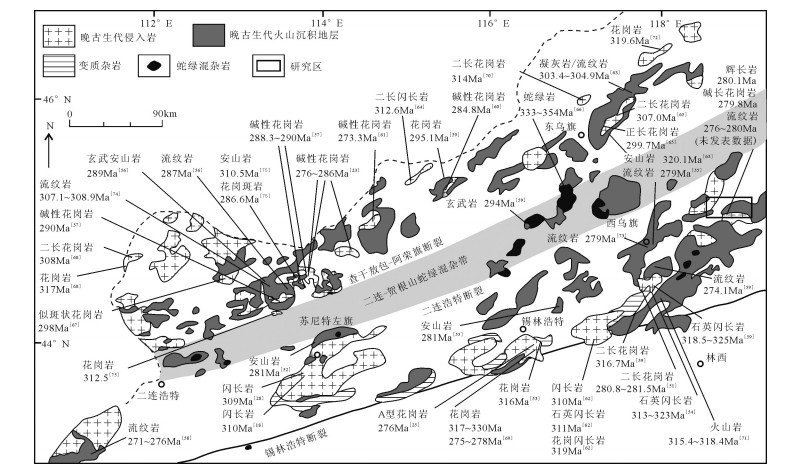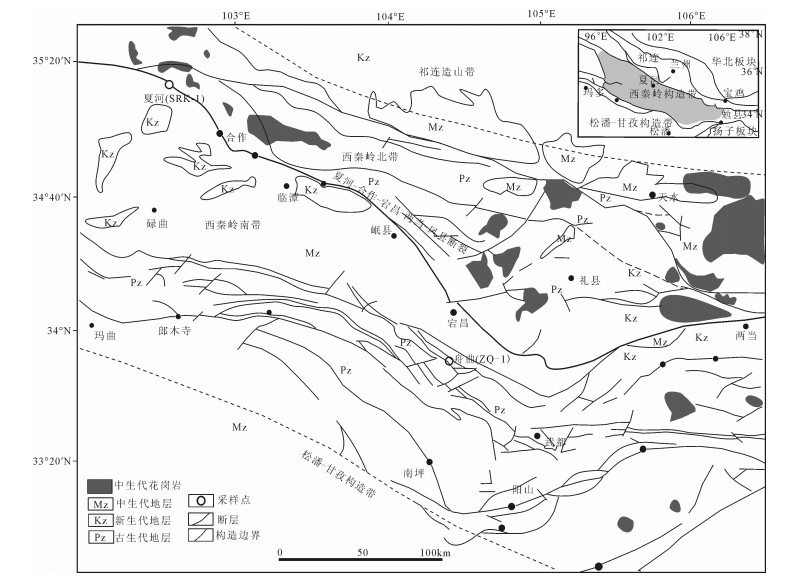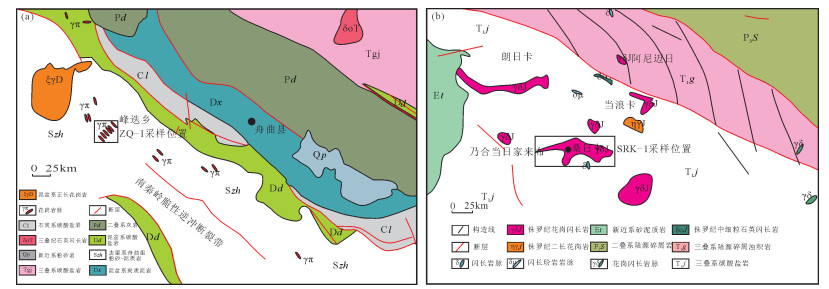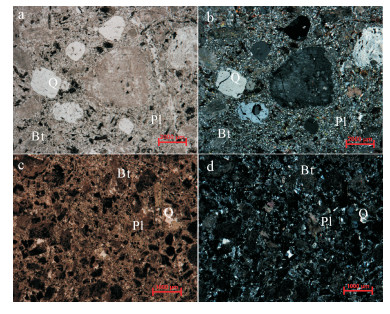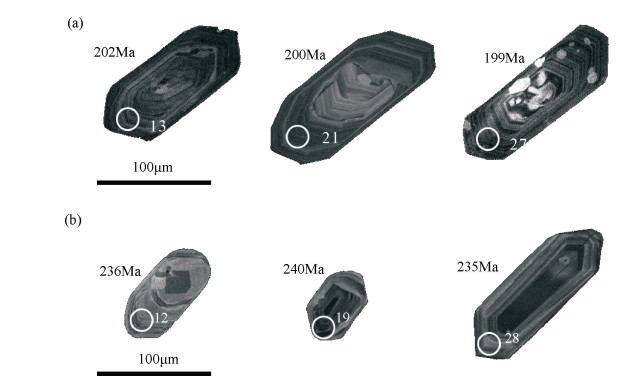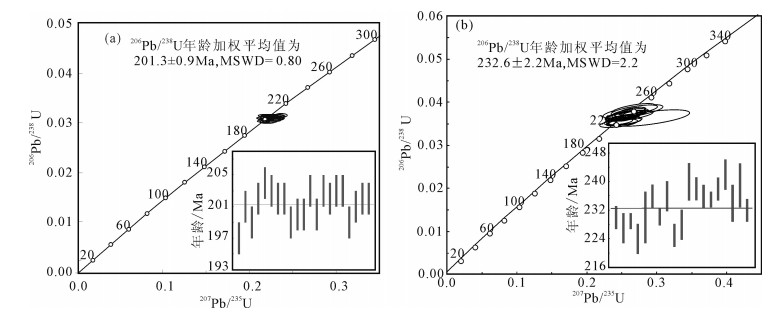Zircon U-Pb ages of Fengdie and Sangrika granitic plutons in West Qinling Orogen and their geological significance
-
摘要:
对西秦岭疑似为燕山期花岗岩的舟曲峰迭和夏河桑日卡岩体进行岩相学研究和锆石U-Pb同位素地质年龄测定,获得锆石U-Pb年龄分别为201.3±0.9Ma和232.6±2.2Ma,表明2个岩体均属早中生代印支期造山作用岩浆活动的产物,澄清了有关地质图(1:25万陇东幅地质图和1:25万临夏市幅建造构造图)中2个岩体的时代归属。通过研究认为,西秦岭内部无论南带或北带基本不存在燕山期花岗岩,其花岗岩主体为出露于北带的印支期花岗岩体。因此,西秦岭可以与东秦岭的南秦岭构造单元对比,在构造带的划分上相当于南秦岭的西延。结合前人研究成果,从西秦岭与南秦岭花岗岩形成时代与同位素地球化学特征看,两者的岩浆源区相似并具有扬子地块基底属性。西秦岭缺少燕山期花岗岩的原因归咎于它的构造位置与东秦岭尤其是燕山期花岗岩极发育的小秦岭完全不同,后者燕山期岩浆作用得以盛行,可能与华北克拉通岩石圈破坏或与中生代中晚期华北地块向秦岭造山带的陆下俯冲有关。
Abstract:In this paper, the authors petrographically studied both Fengdie and Sanrika granitic plutons in Zhouqu County and Xiahe County of West Qinling Orogen and determined their zircon U-P ages. These two plutons which used to be recognized as Yanshanian (Middle-Late Mesozoic) intrusions yielded zircon U-Pb ages of 201.3±0.9Ma and 232.6±2.2Ma, respectively, suggesting that they should be products of the Indosinian (Early Mesozoic) magmatism and thus clarifying their timing in certain geological maps (1:250000). Combining previous age data with the authors' study, the authors argue that there is basically no Yanshanian granite exposed in West Qinling Orogen and the majority of granites of West Qinling Mountain are Indosinian in age and spatially distributed in the northern part of West Qinling Orogen. Therefore, West Qinling can be tectonically compared with South Qinling tectonic unit of East Qinling, and the former is the western extension of the latter. It can be seen from both the age and the geochemical data that Indosinian granites of West Qinling and South Qinling were derived from the similar sources and possessed characteristics of the basement of the Yangtz block. The reason for lacking Yanshanian granite in West Qinling can be attributed to obvious difference of the tectonic location between West Qinling and East Qinling, especially the Xiaoqinling where Yanshanian granites were well developed. The formation of Yanshanina granites in the Xiaoqinling was probably related to the destruction of the North China cratonic lithosphere or to the intracontinental subduction of the North China block.
-
Keywords:
- zircon U-Pb age /
- West Qinling Orogen /
- Yanshanian granite /
- Indosinian granite
-
分隔西伯利亚板块与华北板块的古亚洲洋最终闭合的时间和位置一直是华北板块北缘地质研究的热点问题[1-11],这些问题涉及到该区在古亚洲洋闭合前后的构造位置及构造属性等一系列关键科学问题,进而影响矿产资源勘探的突破,具有重要的资源战略意义。内蒙古中东部地区是古亚洲洋最终闭合的关键部位,也是探讨中亚造山带南缘晚古生代构造演化的突破点。
前人研究表明,内蒙古东部地区由众多微地块组成(图 1-a),自西向东依次为额尔古纳地块、兴安地块、松嫩地块、布列亚-佳木斯地块、兴凯地块[12-13]。古生代以来,各地块伴随着古亚洲洋的消减、关闭而相继拼贴形成统一的东北地块群[9-10, 14-20]。如王成文等[16]指出,东北及其邻区至少在晚古生代已经存在一个统一的“佳-蒙地块”,而西伯利亚与华北板块的拼合实际上是“佳-蒙地块”与华北板块的拼合[12]。关于华北板块和西伯利亚板块的最终缝合位置,主要有沿二连-贺根山蛇绿岩带和索伦缝合带闭合2种观点,最新研究成果大多认为,两大板块最终沿索伦缝合带闭合[2, 9, 18, 21-22]。对于其最终闭合的时限仍具有争议:一种观点认为华北板块与西伯利亚板块在中、晚泥盆世—早石炭世闭合[4-7, 23-27];另一种观点认为两大板块的最终碰撞发生在晚二叠世—早三叠世[9, 28-31]。内蒙古中东部地区广泛发育的晚古生代晚期地层,因其所处的关键地理位置和重要时间节点,为研究以上问题提供了有利线索。
内蒙古地区下二叠统寿山沟组集中分布于西乌旗—林西—巴林左旗一带,尤以西乌旗地区分布最广泛[32-34],为一套海相滨海相碎屑岩组合,横向上表现为:西南部为滨海-浅海环境,东北部为半深海-深海环境[32]。前人从岩石组合、沉积环境、生物化石、碎屑锆石、烃源岩评价[32, 34-40]等方面对寿山沟组进行了大量的研究,也取得了较大的进展。但区域上寿山沟组生物化石稀少,仅在林西西部黄岗梁地区、西乌旗地区发现少量腕足、海百合茎等海相化石[32-33]。由于确定地层时代时缺少同位素测年资料和古生物化石,研究者仅通过岩石地层的对比来确定寿山沟组,从而造成寿山沟组划分标准混乱,无据可依[33],进而影响到该区晚古生代地层分布规律的研究,以及华北板块北缘在晚古生代与中生代之交构造属性的认识,故有必要对寿山沟组进行更加精确的年代学测试。
由于锆石具有较高的U-Th-Pb同位素体系封闭温度(高达900℃)[41],可在低级变质作用和风化搬运过程中保持稳定,因此沉积岩碎屑锆石年代学在限定沉积地层的最大沉积年龄、示踪物源区、恢复形成构造环境等方面得到广泛应用。本文在西乌旗罕乌拉地区1:5万区域地质填图的基础上,选取西乌旗罕乌拉地区寿山沟组作为研究对象,进行剖面实测和岩石学研究,对其中的碎屑锆石进行LAICP-MS U-Pb年龄测试,结合碎屑锆石的年龄谱信息,对该套地层的沉积时代、物源区特征及可能的大地构造意义进行研究,希望为中亚造山带南缘二叠纪构造演化研究提供新的依据。
1. 地质背景
1.1 概况
内蒙古西乌珠穆沁旗位于华北板块与西伯利亚板块夹持的中亚造山带东段(兴蒙造山带)中部,大地构造位置上处于北部贺根山蛇绿岩带和南部索伦缝合带之间的白彦宝力道弧岩浆岩带(图 1-b)。区域上出露最老的地层单元是锡林郭勒变质杂岩,由于变质程度较深,缺乏化石依据,关于该杂岩的时代归属存在较大争议。葛梦春等[42]将锡林浩特地区的“锡林郭勒杂岩”解体为一套表壳岩及新元古代基性-超基性侵入岩和早古生代酸性侵入岩,并将表壳岩厘定为锡林浩特岩群,形成时代推定为中元古代[43]。晚石炭世—二叠纪依次发育本巴图组、阿木山组、寿山沟组、大石寨组、哲斯组海相地层、林西组陆相地层等晚古生代岩石地层单元。区域内岩浆活动频繁,发育晚古生代—新生代侵入岩和火山岩。
1.2 地质特征
研究区位于西乌旗东北部罕乌拉地区,区域上出露的地层单元由老至新依次为中元古界锡林浩特岩群,为一套二云(石英)片岩、含石榴石英片岩夹斜长角闪岩,与下二叠统寿山沟组为逆断层接触。二叠系在该区较发育,地层从下到上依次为下二叠统寿山沟组、大石寨组、中二叠统哲斯组。寿山沟组为一套浅变质海相碎屑岩组合,与大石寨组为逆断层接触。大石寨组为一套海相火山-沉积岩组合。哲斯组为一套滨浅海相碎屑岩夹碳酸盐岩组合,灰岩中发育较丰富的珊瑚、腕足、海百合茎、苔藓虫化石。区内岩浆岩主要发育早二叠世辉长岩、辉石闪长岩及碱长花岗岩侵入体(伊和绍荣复式岩体)、大石寨组火山岩;早、中三叠世花岗闪长岩、二长花岗岩侵入体;早白垩世花岗斑岩、碱长花岗岩;中生代陆相火山岩,呈不整合覆盖于下伏地层之上。
研究区寿山沟组分布及实测剖面(A-A′)位置见图 1-c,实测剖面见图 2。寿山沟组主要分布于研究区南部和北部,出露面积约124km2,地貌上多呈东西向、北西西向展布的高山,与早期基底地层及大石寨组呈逆断层接触,二叠纪和三叠纪岩体侵入其中,被大面积中生界火山岩和第四系覆盖。1:20万罕乌拉幅①将该套地层划分为上、下2段(P1?1、P1?2),归并为下二叠统,但并未对其定组。本次工作根据1:5万区域地质调查成果,经详细的野外地质调查及室内综合分析,将其归为寿山沟组,由下至上分为2个岩性段:下部为灰黄色-灰绿色-灰黑色粉砂质-泥质-凝灰质板岩、灰色-浅灰褐色互层状沉凝灰岩夹灰黑色粉砂质泥岩及泥质粉砂岩,整体为一套含火山物质的海相细碎屑岩组合;上部为灰白色-灰黑色粉砂岩、凝灰质粉砂岩、泥质粉砂岩、泥岩、沉凝灰岩、灰绿色-灰黑色粉砂质-泥质-凝灰质板岩,底部为砂岩、砂砾岩及黑色板岩,发育冲刷构造、粒序层理及鲍马序列,表现为一套有火山物质参与的浅海陆棚-半深海沉积夹重力流沉积的岩石组合。该组岩石多发生轻微变质作用,构造变形较强,硅化、碎裂岩化较普遍,局部发育角岩化。
2. 样品特征及分析测试
2.1 样品及岩相学特征
本次研究的样品为采自西乌旗罕乌拉地区寿山沟组中的长石砂岩(Pm19B31)、泥质板岩(B1401),采样点地理坐标分别为:北纬44°42′16″、东经118°33′59″;北纬44°42′38″、东经118°51′40″。对其进行碎屑锆石LA-ICP-MS U-Pb同位素年代学研究。
长石砂岩多呈浅灰黑色、灰色,变余细砂状结构,中-厚层状构造,岩石变质重结晶程度较低,新生绢云母普遍连成条纹状分布,雏晶黑云母稀疏分布(图版Ⅰ-c、d)。岩屑磨圆呈次圆状,成分为硅质岩、板岩,粒径0.2~0.7mm,少量。砂屑呈次棱角状、次圆状,部分棱角趋于消失,呈粒状或重结晶不规则粒状,少数拉长定向排列,粒径一般为0.1~0.2mm,少量可达0.4mm,成分以斜长石为主,约占50%;石英呈波状消光,约占10%。绢云母呈鳞片状,定向排列,多连成条纹状,分布普遍,含量约25%。雏晶黑云母呈浅褐色,鳞片状,少数小片状,稀疏分布,含量约10%。重结晶微细石英、长石,彼此镶嵌,颗粒细小,部分界线不清,局部少量分布。
泥质板岩呈浅灰黑色、灰黑色,泥状结构,板状构造。岩石碎裂岩化、裂隙较发育,局部细碎或使岩石分割成块,硅化石英呈不规则细脉状或相互穿切,脉宽小于0.5mm(图版Ⅰ-e、f)。粉砂屑磨圆呈次棱角状、粒状,稀疏分布,粒径小于0.1mm,少数达0.2mm,含量小于5%,成分主要为石英和斜长石,偶见玻屑,轮廓消失,脱玻微粒钠长石镶嵌。泥质呈土褐色,分布均匀,其中粘土矿物纤维发育,普遍定向分布,含量约90%。火山碎屑见细小玻屑,条状、粒状,稀疏分布,局部略集中,脱玻霏细粒状长英质,含量小于5%。
2.2 测试方法
锆石单矿物分选由河北省区域地质调查研究所完成。锆石制靶、阴极发光(CL)照相由北京锆年领航科技有限公司完成。锆石U-Pb同位素定年在天津地质矿产研究所利用LA-ICP-MS进行分析,ICP-MS为Agilent7500a。本次实验采用的激光束斑直径为35μm,以氦气作为剥蚀物质的载气。LA-ICP-MS分析的详细方法和流程见李怀坤等[44]。测试数据的计算处理采用Isoplot3.0程序[45]。按照碎屑锆石年龄分布范围,年龄大于1000Ma的锆石,由于含大量放射性成因Pb,采用207Pb/206Pb表面年龄;年龄小于1000Ma的锆石,由于可用于测量的放射性成因Pb含量低和普通Pb校正的不确定性,采用更可靠的206Pb/238U表面年龄[41, 46-47]。
3. 碎屑锆石特征和年龄谱
3.1 碎屑锆石特征
图 3是样品(Pm19B31、B1401)中选取的代表性锆石阴极发光图像。锆石多为浅黄色-粉色,透明-半透明,弱金刚光泽,多呈半自形双锥柱状、短柱状、次浑圆柱粒状等。粒度长度50~120μm,宽度40~80μm,宽窄不一,长宽比为1: 1~2: 1,少数达3: 1。锆石表面较光滑,晶体裂纹发育,常见浅坑、浅沟槽等溶磨痕迹。锆石内部具有明显的岩浆生长振荡环带结构,属于岩浆结晶产物[41, 48]。少量锆石内部结构比较复杂,部分锆石具有残留的核部,为继承核或捕获核;部分锆石颗粒具有窄的浅色边,但核部仍显示清晰的岩浆环带特征,表明浅色边为变质的增生边[41]。
样品(Pm19B31、B1401)测得的同位素比值和年龄数据见表 1。对样品Pm19B31、B1401分别随机选取了63颗和43颗单颗粒锆石进行测试,在U-Pb谐和图中(图 4),绝大多数数据点都落在谐和线上或其附近,表明样品中的锆石U-Pb体系基本保持封闭,绝大多数锆石具有谐和年龄。样品Pm19B31中剔除了3个极不谐和的年龄数据(点34、35、36),对其余的同位素年龄数据进行了统计。样品Pm19B31中所测60颗锆石的Th/U值介于0.4~1.6之间,均大于0.4;样品B1401中所测43颗锆石的Th/U值介于0.13~0.99之间,多数大于0.4,与CL图像分析结果一致,说明绝大多数锆石为岩浆锆石。
表 1 寿山沟组LA-ICP-MS碎屑锆石U-Th-Pb同位素分析结果Table 1. LA-ICP-MS U-Th-Pb data of detrital zircons from Shoushangou Formation点号 含量/10-6 同位素比值 年龄/Ma Pb U 207Pb/
206Pb1σ 207Pb/
235U1σ 206Pb/
238U1σ 208Pb/
232Th1σ 232Th/
238U1σ 207Pb/
206Pb1σ 207Pb/
235U1σ 206Pb/
238U1σ Pm19B31 1 3 53 0.0526 0.0066 0.358 0.044 0.0480 0.0006 0.0085 0.0007 0.557 0.005 312 284 310 38 302 4 2 8 172 0.0519 0.0028 0.330 0.018 0.0461 0.0005 0.0077 0.0002 0.876 0.007 279 124 289 16 290 3 3 1 28 0.0528 0.0106 0.349 0.066 0.0472 0.0008 0.0128 0.0024 0.454 0.004 320 458 304 58 298 5 4 2 30 0.0514 0.0107 0.362 0.070 0.0498 0.0008 0.0117 0.0018 0.607 0.005 260 476 314 61 313 5 5 7 119 0.0765 0.0028 0.540 0.021 0.0509 0.0005 0.0181 0.0006 0.588 0.005 1107 74 438 17 320 3 6 3 57 0.0527 0.0057 0.354 0.038 0.0476 0.0006 0.0150 0.0008 0.599 0.005 316 246 308 33 300 3 7 11 206 0.0538 0.0019 0.353 0.013 0.0476 0.0005 0.0128 0.0002 0.674 0.007 361 82 307 11 299 3 8 14 258 0.0542 0.0019 0.359 0.013 0.0481 0.0005 0.0167 0.0003 0.845 0.007 378 79 312 11 303 3 9 13 258 0.0529 0.0014 0.352 0.010 0.0481 0.0005 0.0148 0.0003 0.406 0.005 326 60 306 8 303 3 10 3 53 0.0504 0.0050 0.350 0.035 0.0489 0.0005 0.0152 0.0008 0.624 0.005 211 232 305 30 308 3 11 30 540 0.0543 0.0012 0.354 0.008 0.0472 0.0005 0.0158 0.0002 0.946 0.010 384 48 308 7 298 3 12 44 872 0.0519 0.0008 0.351 0.006 0.0491 0.0005 0.0144 0.0001 0.503 0.006 282 35 306 5 309 3 13 65 1163 0.0535 0.0008 0.375 0.006 0.0509 0.0005 0.0186 0.0001 0.558 0.006 349 36 323 5 320 3 14 18 360 0.0538 0.0011 0.354 0.008 0.0477 0.0005 0.0159 0.0002 0.563 0.005 361 47 307 7 300 3 15 3 48 0.0539 0.0064 0.367 0.044 0.0492 0.0006 0.0152 0.0011 0.613 0.005 366 268 317 38 310 4 16 2 46 0.0536 0.0092 0.334 0.055 0.0452 0.0007 0.0220 0.0013 0.665 0.006 356 385 293 48 285 4 17 18 344 0.0527 0.0011 0.349 0.008 0.0480 0.0005 0.0185 0.0002 0.497 0.005 315 49 304 7 302 3 18 15 288 0.0533 0.0015 0.354 0.010 0.0482 0.0005 0.0189 0.0002 0.532 0.006 340 62 308 9 303 3 19 4 89 0.0551 0.0036 0.351 0.023 0.0459 0.0005 0.0151 0.0007 0.572 0.004 416 146 306 20 290 3 20 5 80 0.0534 0.0041 0.374 0.029 0.0504 0.0005 0.0261 0.0007 0.515 0.004 344 174 322 25 317 3 21 44 861 0.0521 0.0008 0.345 0.006 0.0481 0.0005 0.0197 0.0001 0.441 0.003 288 36 301 5 303 3 22 32 601 0.0524 0.0009 0.348 0.006 0.0482 0.0005 0.0218 0.0001 0.449 0.004 301 39 303 6 304 3 23 78 1218 0.0861 0.0013 0.608 0.010 0.0512 0.0005 0.0341 0.0002 0.539 0.004 1340 29 482 8 322 3 24 2 38 0.0543 0.0073 0.372 0.0499 0.0497 0.0007 0.0330 0.0012 0.717 0.006 385 303 321 43 313 4 25 9 156 0.0525 0.0027 0.339 0.017 0.0468 0.0005 0.0255 0.0003 0.828 0.008 309 115 296 15 295 3 26 2 31 0.0524 0.0102 0.342 0.067 0.0474 0.0008 0.0292 0.0015 0.642 0.005 303 445 299 58 298 5 27 10 177 0.0527 0.0017 0.350 0.011 0.0481 0.0005 0.0238 0.0002 0.708 0.007 315 72 304 10 303 3 28 27 476 0.0541 0.0012 0.357 0.008 0.0479 0.0005 0.0352 0.0003 0.436 0.003 373 51 310 7 302 3 29 26 452 0.0532 0.0011 0.357 0.008 0.0486 0.0005 0.0325 0.0002 0.437 0.004 339 46 310 6 306 3 30 26 333 0.0779 0.0015 0.534 0.011 0.0496 0.0005 0.0387 0.0002 0.911 0.013 1145 38 434 9 312 3 31 8 103 0.0543 0.0038 0.359 0.025 0.0480 0.0005 0.0392 0.0003 0.919 0.008 382 157 312 22 302 3 32 14 217 0.0536 0.0021 0.350 0.014 0.0473 0.0005 0.0403 0.0003 0.551 0.006 355 88 304 12 298 3 33 25 350 0.0543 0.0013 0.362 0.009 0.0483 0.0005 0.0407 0.0001 0.761 0.006 383 54 313 8 304 3 34 19 239 0.1195 0.0027 0.788 0.019 0.0478 0.0005 0.0577 0.0005 0.684 0.009 1948 41 590 14 301 3 35 15 192 0.1228 0.0029 0.868 0.021 0.0512 0.0005 0.0683 0.0004 0.481 0.009 1997 41 635 16 322 3 36 35 332 0.2133 0.0033 1.458 0.024 0.0496 0.0005 0.0721 0.0004 0.828 0.010 2931 25 913 15 312 3 37 18 252 0.0534 0.0016 0.361 0.011 0.0490 0.0005 0.0323 0.0001 1.009 0.013 345 67 313 9 309 3 38 29 366 0.0528 0.0012 0.367 0.009 0.0504 0.0005 0.0371 0.0001 0.985 0.007 320 53 317 8 317 3 39 20 247 0.0548 0.0014 0.394 0.011 0.0521 0.0005 0.0331 0.0001 1.106 0.015 403 58 337 9 328 3 40 36 661 0.0540 0.0009 0.355 0.006 0.0476 0.0005 0.0227 0.0001 0.577 0.005 373 37 308 5 300 3 41 14 248 0.0539 0.0016 0.346 0.010 0.0466 0.0004 0.0189 0.0002 0.741 0.006 366 66 302 9 294 3 42 33 611 0.0524 0.0009 0.360 0.007 0.0499 0.0005 0.0193 0.0001 0.527 0.004 302 40 312 6 314 3 43 24 383 0.0532 0.0010 0.394 0.008 0.0538 0.0005 0.0254 0.0002 0.593 0.005 339 44 338 7 338 3 44 77 915 0.0818 0.0012 0.575 0.009 0.0510 0.0005 0.0267 0.0002 1.559 0.011 1240 29 461 7 321 3 45 12 139 0.0540 0.0023 0.406 0.017 0.0545 0.0005 0.0631 0.0004 0.602 0.005 371 95 346 15 342 3 46 33 313 0.0536 0.0012 0.361 0.009 0.0488 0.0005 0.0530 0.0001 1.308 0.015 356 52 313 7 307 3 47 26 298 0.0556 0.0013 0.390 0.009 0.0509 0.0005 0.0770 0.0002 0.604 0.005 435 51 334 8 320 3 48 28 218 0.0530 0.0018 0.377 0.013 0.0514 0.0005 0.0748 0.0001 1.242 0.011 329 77 325 11 323 3 49 13 94 0.0792 0.0033 0.632 0.027 0.0576 0.0006 0.1460 0.0006 0.644 0.011 1177 81 498 21 361 4 50 11 133 0.0531 0.0030 0.353 0.020 0.0481 0.0005 0.0840 0.0005 0.568 0.008 332 127 307 17 303 3 51 16 143 0.0658 0.0027 0.455 0.019 0.0503 0.0005 0.0882 0.0003 0.831 0.007 799 87 381 16 316 3 52 4 64 0.0523 0.0056 0.344 0.037 0.0473 0.0005 0.0543 0.0010 0.523 0.007 299 246 300 32 298 3 53 9 95 0.0549 0.0034 0.357 0.022 0.0469 0.0005 0.0434 0.0002 1.371 0.012 410 137 310 19 295 3 54 5 87 0.0529 0.0040 0.344 0.026 0.0466 0.0005 0.0304 0.0005 0.651 0.006 323 172 300 23 294 3 55 19 330 0.0507 0.0013 0.328 0.009 0.0469 0.0005 0.0229 0.0001 0.805 0.006 229 60 288 8 296 3 56 36 683 0.0557 0.0009 0.373 0.006 0.0485 0.0005 0.0147 0.0001 0.627 0.007 441 36 322 6 306 3 57 12 215 0.0532 0.0019 0.345 0.013 0.0470 0.0005 0.0126 0.0001 1.084 0.009 339 80 301 11 296 3 58 12 224 0.0535 0.0016 0.353 0.011 0.0478 0.0005 0.0154 0.0004 0.661 0.016 350 70 307 10 301 3 59 20 398 0.0548 0.0011 0.371 0.008 0.0492 0.0005 0.0132 0.0002 0.535 0.006 403 46 321 7 310 3 60 36 678 0.0538 0.0009 0.352 0.006 0.0475 0.0005 0.0103 0.0001 0.999 0.009 361 38 307 6 299 3 61 3 49 0.0531 0.0091 0.361 0.060 0.0481 0.0006 0.0118 0.0008 0.906 0.008 332 391 313 52 303 4 62 39 757 0.0531 0.0010 0.333 0.008 0.0455 0.0005 0.0089 0.0002 1.349 0.031 332 44 292 7 287 3 63 11 228 0.0540 0.0018 0.358 0.012 0.0481 0.0005 0.0091 0.0003 0.605 0.009 369 73 311 10 303 3 B1401 1 4 72 0.0889 0.0049 0.618 0.036 0.0504 0.0004 0.0211 0.0005 0.506 0.001 1402 106 488 28 317 3 2 5 93 0.0847 0.0029 0.532 0.019 0.0455 0.0003 0.0195 0.0003 0.522 0.005 1309 66 433 15 287 2 3 46
81166 0.1530 0.0011 8.205 0.060 0.3888 0.0019 0.1177 0.0002 0.130 0.002 2380 12 2254 17 2117 10 4 41 555 0.0569 0.0006 0.612 0.006 0.0781 0.0004 0.0260 0.0003 0.141 0.001 486 23 485 5 485 3 5 10 194 0.0862 0.0022 0.556 0.014 0.0468 0.0003 0.0243 0.0003 0.348 0.002 1342 50 449 11 295 2 6 13 269 0.0672 0.0016 0.452 0.010 0.0488 0.0003 0.0204 0.0003 0.285 0.002 845 48 379 8 307 2 7 9 178 0.0596 0.0018 0.397 0.012 0.0483 0.0003 0.0201 0.0003 0.295 0.001 589 66 339 11 304 2 8 42 750 0.0573 0.0006 0.379 0.004 0.0479 0.0002 0.0184 0.0001 0.788 0.007 504 22 326 3 302 1 9 7 127 0.0880 0.0043 0.565 0.030 0.0466 0.0003 0.0310 0.0011 0.369 0.003 1382 93 455 24 293 2 10 20 332 0.0679 0.0014 0.456 0.010 0.0486 0.0003 0.0262 0.0002 0.616 0.006 866 44 381 8 306 2 11 23 397 0.0850 0.0014 0.530 0.010 0.0452 0.0002 0.0254 0.0003 0.700 0.002 1316 32 431 8 285 1 12 22 360 0.0854 0.0033 0.594 0.025 0.0505 0.0003 0.0318 0.0009 0.536 0.003 1325 74 474 20 317 2 13 4 67 0.0861 0.0038 0.580 0.026 0.0488 0.0003 0.0304 0.0006 0.617 0.006 1340 85 464 20 307 2 14 21 362 0.0582 0.0011 0.383 0.007 0.0477 0.0002 0.0271 0.0002 0.653 0.001 537 40 329 6 301 2 15 7 101 0.0879 0.0026 0.594 0.019 0.0490 0.0003 0.0258 0.0004 0.965 0.004 1380 58 473 15 309 2 16 68 894 0.0583 0.0005 0.588 0.005 0.0731 0.0004 0.0424 0.0002 0.248 0.001 541 18 469 4 455 2 17 5 81 0.0675 0.0057 0.452 0.040 0.0486 0.0004 0.0315 0.0006 0.537 0.001 853 174 379 33 306 3 18 7 115 0.0554 0.0021 0.365 0.014 0.0479 0.0003 0.0273 0.0003 0.609 0.003 426 83 316 12 301 2 19 28 516 0.0557 0.0008 0.368 0.005 0.0479 0.0002 0.0232 0.0001 0.505 0.001 441 32 318 5 301 1 20 23 434 0.0636 0.0013 0.422 0.009 0.0481 0.0002 0.0249 0.0002 0.375 0.001 728 43 357 7 303 1 21 12 211 0.0653 0.0022 0.440 0.015 0.0488 0.0003 0.0204 0.0003 0.584 0.001 784 70 370 12 307 2 22 57 610 0.0882 0.0011 0.960 0.010 0.0789 0.0006 0.0618 0.0006 0.345 0.004 1387 25 683 7 490 4 23 9 154 0.0543 0.0027 0.357 0.018 0.0477 0.0003 0.0205 0.0003 0.789 0.002 383 110 310 16 300 2 24 29 459 0.0592 0.0018 0.393 0.012 0.0482 0.0002 0.0232 0.0001 0.991 0.002 574 65 337 10 303 2 25 12 194 0.0867 0.0041 0.662 0.036 0.0554 0.0005 0.0267 0.0007 0.510 0.001 1353 91 516 28 347 3 26 20 397 0.0519 0.0012 0.340 0.007 0.0474 0.0004 0.0167 0.0003 0.433 0.001 281 53 297 6 299 3 26 20 397 0.0519 0.0012 0.340 0.007 0.0474 0.0004 0.0167 0.0003 0.433 0.001 281 53 297 6 299 3 27 11 211 0.0548 0.0013 0.362 0.009 0.0479 0.0002 0.0121 0.0002 0.881 0.023 405 53 314 7 302 2 28 11 209 0.0711 0.0018 0.483 0.012 0.0493 0.0003 0.0188 0.0003 0.402 0.004 961 51 400 10 310 2 29 8 142 0.0645 0.0019 0.431 0.013 0.0484 0.0003 0.0158 0.0002 0.616 0.002 757 63 364 11 305 2 30 7 143 0.0856 0.0090 0.535 0.063 0.0453 0.0005 0.0177 0.0013 0.586 0.004 1329 203 435 51 286 3 31 6 99 0.0901 0.0040 0.629 0.033 0.0506 0.0003 0.0187 0.0006 0.856 0.013 1427 85 495 26 318 2 32 44 354 0.0879 0.0012 1.510 0.017 0.1246 0.0009 0.0354 0.0006 0.260 0.002 1380 25 934 11 757 5 33 51 292 0.0834 0.0007 2.019 0.016 0.1756 0.0009 0.0574 0.0010 0.194 0.003 1278 17 1122 9 1043 5 34 52 937 0.0712 0.0010 0.483 0.007 0.0492 0.0002 0.0144 0.0001 0.773 0.003 963 30 400 6 309 1 35 17 301 0.0896 0.0027 0.614 0.027 0.0497 0.0004 0.0197 0.0008 0.466 0.002 1416 58 486 21 313 2 36 13 246 0.0884 0.0012 0.581 0.008 0.0476 0.0002 0.0156 0.0002 0.569 0.008 1391 27 465 7 300 2 37 16 275 0.0697 0.0010 0.473 0.007 0.0492 0.0002 0.0155 0.0001 0.801 0.003 918 29 393 5 310 2 38 12 222 0.0743 0.0012 0.503 0.008 0.0491 0.0002 0.0154 0.0001 0.759 0.001 1050 32 414 7 309 2 39 22 386 0.0886 0.0026 0.628 0.020 0.0514 0.0003 0.0167 0.0003 0.623 0.002 1396 56 495 16 323 2 40 16 273 0.0883 0.0016 0.617 0.011 0.0507 0.0002 0.0159 0.0001 0.748 0.002 1390 35 488 9 319 2 41 28 571 0.0861 0.0013 0.548 0.009 0.0461 0.0002 0.0123 0.0002 0.548 0.004 1341 29 444 8 291 2 42 27 529 0.0876 0.0024 0.565 0.017 0.0467 0.0002 0.0155 0.0004 0.473 0.001 1374 52 455 14 294 2 43 6 109 0.0875 0.0025 0.595 0.018 0.0493 0.0003 0.0160 0.0003 0.604 0.003 1372 54 474 14 310 2 44 7 152 0.0676 0.0028 0.453 0.020 0.0486 0.0003 0.0078 0.0003 0.397 0.007 855 85 379 16 306 2 3.2 年龄分布特征
样品Pm19B31中测得最年轻锆石和最古老锆石年龄分别为285Ma和361Ma(图 5;表 1)。测试数据年龄值和频率分布特征显示:碎屑锆石206Pb/238U年龄集中在285~328Ma之间,有57颗锆石,占总数的95%,呈现最强烈峰值的特征,峰值年龄为302Ma;另有3颗锆石年龄分别为338Ma、342Ma、361Ma。样品B1401中最年轻锆石和最古老锆石年龄分别为285Ma和2117Ma。测试数据年龄值和频率分布特征显示,碎屑锆石206Pb/238U年龄集中在285~323Ma之间,有37颗锆石,占总数的84%,呈现最强烈峰值的特征,峰值年龄为302Ma,具有287Ma、308Ma、318Ma的次高峰;347Ma的锆石样品1颗;具有早古生代年龄信息的碎屑锆石3颗,分别为455Ma、485Ma、490Ma;具有元古宙年龄信息的碎屑锆石2颗(3个测试点),分别为757Ma、1278Ma、2380Ma。从寿山沟组2个样品的碎屑锆石年龄谱特征看(图 5-a、b),尽管2个样品在时代跨度上有差异,但其所呈现出的峰值特征基本一致,因此可以合并讨论有关问题(图 5-c)。综合分析,寿山沟组碎屑锆石(103颗,共104个测试点)代表的年龄信息可划分为285~328Ma(94颗)、338~361Ma(4颗)、早古生代455~490Ma(3颗)、新元古代757Ma(1颗)、中—古元古代1278Ma和2380Ma(2颗)。与郑月娟等[33]研究的西乌旗塔宾庙林场寿山沟组碎屑锆石年龄图谱特征相似(图 5-d)。
![]() 图 5 单颗粒碎屑锆石LA-ICP-MS U-Pb年龄频谱图(d据参考文献[33])Figure 5. LA-ICP-MS U-Pb age frequency diagram of single detrital zircons
图 5 单颗粒碎屑锆石LA-ICP-MS U-Pb年龄频谱图(d据参考文献[33])Figure 5. LA-ICP-MS U-Pb age frequency diagram of single detrital zircons4. 讨论
4.1 沉积时限的限定
关于寿山沟组的沉积时限,前人从地层古生物方面进行了研究,认为其形成于早二叠世[34, 38, 49],层位相当于Sakmarian阶—Artinskian阶[49]或Kungurian阶最晚期[38]。碎屑锆石方面:Scott等[50]对大石寨地区寿山沟组碎屑岩进行碎屑锆石研究,认为该组地层的形成时间晚于269Ma;郑月娟等[33]根据西乌旗塔宾庙林场寿山沟组最年轻的一组锆石U-Pb年龄的峰值289Ma,认为其沉积时间应该晚于289Ma,为早二叠世Sakmarian期以后。西乌旗地区侵入寿山沟组的前进场和达青二长花岗岩年龄分别为280.8±3.6Ma和281.5±0.5Ma[51]。研究区伊和绍荣复式岩体侵入到寿山沟组内,侵入接触关系明确,接触带边部发育角岩化,在岩体内部可见寿山沟组变质砂岩捕虏体,侵入岩锆石U-Pb年龄为280.1± 1.3Ma(未发表数据)。根据研究区寿山沟组2个样品中最年轻的锆石年龄(285Ma),推测该地层沉积时限介于285~280Ma之间。结合前人资料,寿山沟组主体沉积时代应为早二叠世Sakmarian期—Artinskian期。
4.2 碎屑锆石年龄谱信息及物源区特征
4.2.1 碎屑锆石年龄谱信息
(1)早石炭世末—早二叠世早期年龄信息
285~328Ma为样品最年轻的峰值区间,也是主要碎屑岩锆石的分布区间。该年龄段锆石约占锆石总数的90%,峰值302Ma。该年龄组代表的是早石炭世末—早二叠世早期的构造岩浆热事件的年龄谱。
从已发表的资料看,该组年龄代表的岩浆事件主要分布于二连-贺根山蛇绿岩带两侧的西乌旗、东乌旗等地区(表 2;图 6)[18, 23, 25, 28, 51-75]。在苏尼特左旗—锡林浩特—西乌旗南一带见有大量早石炭世末—晚石炭世(300~325Ma)岩浆活动的报道[28, 42, 53-54, 59, 62, 76-78];锡林浩特地区早石炭世变质基性火山岩年龄为334.5±3.5Ma、323.4±2.4Ma[79];本巴图组火山岩喷发年龄为301~324Ma[59, 80-81];西乌旗—东乌旗地区分布的宝力高庙组火山岩年龄介于305~320Ma之间[63, 82]。在二连—东乌旗地区有晚石炭世(307~314Ma)岩浆活动的报道[64-65, 70]。东乌旗地区格根敖包组火山岩年代介于307~323Ma之间[22, 83]。早二叠世早期岩浆活动(279~295Ma)主要发生于东乌旗和二连浩特北部一带[23, 76, 60, 84]。在贺根山蛇绿岩中的浅色辉长岩、辉绿岩脉和块状玄武岩中也有该期年龄(293~298Ma)的报道[15, 59]。
表 2 主要构造岩浆事件年龄值统计Table 2. The dating results of main geological events事件 地质体 年龄 测试方法 资料来源 早二叠世早期岩浆事件 白音乌拉-东乌旗碱性-碱长花岗岩带 286~279Ma Rb-Sr [23] 白音乌拉正长花岗岩 293~294Ma SHRIMP [84] 白音乌拉-东乌旗罕布音布敦岩体 295.1±2.8Ma LA-ICP-MS [59] 东乌旗京格斯台碱性花岗岩 284.8±1.1Ma TIMS [60] 贺根山浩雅尔洪克尔玄武岩 294±30Ma LA-ICP-MS [59] 贺根山西南块状玄武岩 292.9±0.6Ma Ar-Ar [15] 朝克山辉长岩、基性脉岩 295±15Ma、298±9Ma SHRIMP [15] 晚石炭世—早石炭世末岩浆事件 苏左旗白音宝力道岩体 309Ma SHRIMP [28] 锡林浩特东南石榴石花岗岩 316士3Ma SHRIMP [53] 锡林浩特片麻状二长花岗岩、花岗闪长岩 316.5±1.8Ma、324±2.4Ma SHRIMP [42] 锡林浩特水库地区Ⅰ型花岗岩 317.0±4.0Ma LA-ICP-MS [77] 维拉斯托石英闪长岩和闪长岩、拜仁达坝花岗闪长岩 310±2Ma、11±2Ma SHRIMP [62] 以及道伦达坝英安质晶屑凝灰岩 319±3Ma、300±5Ma 锡林浩特变质基性火山岩 334.5±3.5Ma、323.4±2.4Ma LA-ICP-MS [79] 西乌旗达其浑迪、金星石英闪长岩 325±3Ma、322±3Ma LA-ICP-MS [76] 西乌旗巴音高勒苏木白音陶勒盖二云母花岗岩 316.7±2.1Ma LA-ICP-MS [59] 西乌旗白音高勒石英闪长岩 313~323Ma SHRIMP [54] 西乌旗梅劳特乌拉蛇绿岩中块状辉长岩 308.5±2.2Ma LA-ICP-MS [78] 苏尼特右旗本巴图组安山岩 300.9 ± 1.6 Ma LA-ICP-MS [80] 西乌旗达青牧场本巴图组片理化火山岩 318.4±3.4Ma、315.4±4.4Ma LA-ICP-MS [59] 扎鲁特旗巴雅尔吐胡硕本巴图组凝灰岩 323.9±3.5Ma LA-ICP-MS [59] 查干诺尔地区本巴图组火山岩 308~313Ma SHRIMP [81] 东乌旗狠麦温都尔二长花岗岩、正长花岗岩 307.0±1.9Ma、299.7±5.3 Ma SHRIMP [65] 东乌珠穆沁旗阿木古楞岩体含巨斑二长花岗岩 314.2±2.2Ma LA-ICP-MS [70] 莫若格钦二长闪长岩 312.6±4.1M a SHRIM P [64] 白音乌拉地区宝力高庙组流纹岩 300.0±2.9Ma SHRIMP [82] 东乌旗狠麦温都尔宝力高庙组火山岩 305~320Ma SHRIMP [63] 东乌旗格根敖包组火山岩 307.3±0.99Ma、311.6±1.3Ma LA-ICP-MS [83] 贺根山格根敖包组晶屑凝灰岩 323±3Ma LA-ICP-MS [22] 贺根山蛇绿岩中辉长闪长岩和玄武岩 341±3Ma和359±5Ma LA-ICP-MS [22] 早古生代岩浆事件 苏左旗地区闪长-花岗岩 464~490Ma SHRIMP [86] 锡林浩特片麻状电气石二云母花岗岩 458.8Ma SHRIMP [42] 小兴安岭片麻状花岗闪长岩-二长花岗岩、花岗闪长 508±15Ma、499±1Ma Rb-Sr [89] 岩-二长花岗岩、碱长-碱性花岗岩 、471±3Ma LA-ICP-MS 黑龙江东南部穆棱地区片麻状花岗岩 486±3Ma SHRIMP [91] 钾长花岗岩 461±6Ma SHRIMP [91] 额尔古纳地块塔河花岗岩 480~494Ma LA-ICP-MS [90] 大兴安岭东北部早古生代花岗岩 460~500Ma LA-ICP-MS [88] 松辽盆地基底变质岩锆石年龄 448Ma (424~490Ma) LA-ICP-MS [93-94] 兴华渡口群变火成岩 506±10~547±46Ma SHRIMP [92] 扎兰屯变质杂岩碎屑锆石 481~580Ma,峰期529Ma LA-ICP-MS [95] 额尔古纳地块漠河杂岩 494±3Ma LA-ICP-MS [99] 兴安地块兴华渡口群 496±7Ma LA-ICP-MS [98] 松辽地块铁力变质杂岩 514±5Ma LA-ICP-MS [100] 兴凯地块虎头杂岩 490±4Ma LA-ICP-MS [103-104] 佳木斯地块麻山群的岩浆锆石年龄 515Ma SHRIMP [96-97] 新元古代岩浆事件 “黑龙江群”中斜长角闪片岩结晶年龄 777±18Ma SHRIMP [91] 锡林浩特地区变辉长岩年龄 739.6±19.3Ma SHRIMP [42] 大兴安岭碧水一带碱性长石花岗、花岗闪长岩 795±13Ma、792±5Ma LA-ICP-MS [101] 大兴安岭满归一带碱性长石花岗岩 927±13Ma LA-ICP-MS [101] 大兴安岭奇乾一带二长花岗岩 817±6Ma LA-ICP-MS [101] 大兴安岭地区兴华渡口群片麻岩 843±6Ma LA-ICP-MS [101] 黑龙江东南秣陵地区麻山群 843~1004Ma SHRIMP [91] 佳木斯地块麻山群石榴石麻粒岩碎屑锆石 843~1004Ma SHRIMP [96-97] 佳木斯地块麻山群夕线石榴片麻岩 687~962Ma, LA-ICP-MS [98-99] 兴凯地块夕线石榴片麻岩的核部年龄 608~1073Ma LA-ICP-MS [98-99] 额尔古纳地块漠河杂岩原岩年龄 615~850Ma LA-ICP-MS [99] 兴安地块兴华渡口群原岩年龄 660~970Ma LA-ICP-MS [98] 兴凯地块虎头杂岩夕线石榴片麻岩原岩年龄 678~1373Ma LA-ICP-MS [103-104] 扎兰屯变质杂岩碎屑锆石 699~998Ma LA-ICP-MS [95] 中元古代—古元古代岩浆事件 大兴安岭东北部花岗岩 1.0~1.4Ga Hf模式年龄 [88] 大兴安岭北部兴华渡口群眼球状花岗片麻岩和条带 1741±30~1837±5Ma SHRIMP [105] 状片麻岩的正片麻岩 LA-ICP-MS 兴凯地块虎头群矽线石榴片麻岩 1300Ma LA-ICP-MS [104] 兴华渡口群变碎屑岩碎屑锆石 1.6~1.8Ga、2.5~2.6Ga SHRIMP [92] 兴安地块兴华渡口群碎屑锆石 1496±23~2791±18Ma LA-ICP-MS [98] 松辽盆地基底变质岩碎屑锆石 1823~2564Ma LA-ICP-MS [93-94] 松辽地块铁力杂岩碎屑锆石 1857~2442Ma LA-ICP-MS [100] 扎兰屯变质杂岩碎屑锆石 1213~3200Ma LA-ICP-MS [95] (2)早石炭世早期年龄信息
338~361Ma区间的锆石共4颗,年龄分别为338Ma、342Ma、347Ma、361Ma。在西乌旗塔宾庙林场寿山沟组中亦见有类似年龄[33],代表早石炭世早期构造岩浆热事件的年龄谱。黄波等[22]报道了贺根山蛇绿岩中辉长闪长岩341±3Ma和玄武岩359± 5Ma的年龄。在锡林郭勒杂岩片麻岩[53]、本巴图组碎屑锆石年龄[85]中也有该期年龄的报道。
(3)早古生代年龄信息
455~490Ma区间的锆石共3颗,年龄分别为455Ma、485Ma、490Ma。在西乌旗本巴图组碎屑锆石中见457~543Ma,峰期年龄为513Ma的信息[85];在西乌旗塔宾庙林场寿山沟组有502±6Ma的锆石年龄[33]。该年龄组代表早古生代构造岩浆热事件的年龄谱。区域上有苏尼特左旗-锡林浩特-西乌旗岩浆弧中的早古生代(458Ma~498Ma)岩浆事件的报道[17, 21, 42, 86]。前人研究表明,泛非期岩浆作用在东北地区广泛分布(表 2),大致可分为550~510Ma和500~460Ma两期[13],该年龄组也与东北地区泛非期构造热事件吻合[87-100]。
(4)新元古代年龄信息
757Ma的碎屑锆石仅1颗。在西乌旗地区本巴图组(724~996Ma)、塔宾庙林场寿山沟组(764 ± 10Ma、915±11Ma)中均有新元古代的年龄信息[33, 85]。在锡林浩特地区,侵入锡林浩特岩群的变辉长岩年龄为739.6Ma[42]。最新研究显示,东北地区的微陆块(额尔古纳地块、兴安地块、松辽地块、佳木斯地块等)也存在新元古代的构造热演化事件的年龄数据记录(表 2)[13, 91, 95-99, 101-104]。
(5)中—古元古代年龄信息
1278Ma、2380Ma的碎屑锆石共2颗。在西乌旗本巴图组中见1031~1836Ma(峰期1572Ma)和2469~2505Ma(峰期2487Ma)的年龄信息[85];在西乌旗塔宾庙林场寿山沟组中见有1826Ma~2490Ma的碎屑锆石年龄[33],其代表中元古代—古元古代的年龄信息。中元古代—古元古代年龄数据在东北地区亦见有报道(表 2)[53, 88, 92-95, 100, 104-106]。
4.2.2 物源区特征
本文的碎屑锆石年龄频率分布显示,285~328Ma为该碎屑岩锆石的主要年龄区间,约占锆石总数的90%,反映其沉积物源主要来自早石炭世末—早二叠世早期的火山(岩浆)物质。锆石CL图像显示,锆石大多数晶形完好,呈棱柱状,磨圆度较差,反映碎屑沉积物距离物源近、快速沉积的特点,表明物源区可能就在附近,其南侧苏尼特左旗—锡林浩特—西乌旗一带的岩浆弧及其区域内的锡林郭勒杂岩可作为物源。
张能[39]对内蒙古科尔沁右翼前旗寿山沟组岩石地球化学分析表明,寿山沟组碎屑岩成分主要为富硅和富铝的石英长石类矿物,物源主要来自上地壳,但有深部部分基性岩物质的加入。贺根山蛇绿岩形成时代至今仍存在争议,但其至少在晚石炭世或早二叠世已经就位[22, 59, 107]。贺根山地区中二叠统哲斯组碎屑岩沉积与蛇绿岩不整合接触[22, 107],缺少早二叠世的地层沉积。东乌旗地区晚石炭世宝力高庙组不整合于泥盆系之上,与上覆上二叠统林西组呈不整合接触[59]。以上说明,研究区北部的贺根山—东乌旗一带,早二叠世处于剥蚀状态,可能为寿山沟组的沉积提供物源。
从已发表的年龄资料看,东北与华北板块具有不同的年龄谱[104, 108-111],华北板块的前寒武纪基底岩石主要由新太古代花岗岩和片麻岩,以及古元古代变质沉积序列构成,岩石年龄主要以1800Ma和2500Ma为代表;东北地块以500Ma左右的泛非期事件及新元古代的岩浆活动为典型代表[13, 104, 108-111]。寿山沟组碎屑锆石年龄谱455~490Ma、757Ma,反映的构造热事件与东北地区微地块一致。综合以上资料,说明寿山沟组碎屑锆石中古老锆石的物源区很可能来自东北地区,而与华北板块无关。
4.3 早二叠世构造属性
前人对华北板块北缘早二叠世大地构造背景的认识一直存在争议,主要有以下2种观点:①古亚洲洋闭合后拉张环境下的陆内裂谷或裂陷槽[4-6, 25-27, 112-113];②与古亚洲洋俯冲有关的大陆边缘弧或岛弧环境或弧后盆地背景[52, 59, 114-115]。张能[39]对内蒙古科尔沁右翼前旗寿山沟组的岩石地球化学分析表明,寿山沟组碎屑岩反映了大陆岛弧环境,推断其形成于陆缘海盆;陈贤等[40]认为,大石寨地区吴家屯组—大石寨组—寿山沟组可能为同时期不同构造背景下沟-弧-盆沉积体系的产物。区域研究表明,苏左旗、锡林浩特和西乌旗地区均发育晚石炭世—早二叠世强烈的岩浆作用,显示岛弧型花岗岩的特征[28, 59, 79, 114-116]。研究区内发育早二叠世双峰式岩石组合及A型火山岩(275~280Ma),表明这一时期该区应处于伸展构造体制,其地球化学特征显示岛弧火山岩的属性(未发表数据)。寿山沟组碎屑锆石显示,其碎屑沉积物距离物源近、快速沉积的特点,且沉积物源中含有较多的火山碎屑物,砂岩多为矿物成熟度及结构成熟度较低的杂砂岩类。结合区域资料,研究区早二叠世寿山沟组可能代表弧后盆地环境沉积。
4.4 古亚洲洋闭合位置和时间
前人关于华北与西伯利亚两大板块的最后缝合位置与时代长期存在分歧[1-11]。本文及西乌旗地区本巴图组[85]、寿山沟组[33]和哲斯组[117]、林西地区林西组[118-119]的碎屑锆石中均发育泛非期和新元古代岩浆锆石,但马收先等[120]对分布于索伦缝合带南侧的华北北缘上石炭统—中三叠统的碎屑锆石的研究却未发现,进一步表明西乌旗地区与东北各地块的大地构造属性一致,而与华北板块没有明显的亲缘关系。以上研究佐证了华北与西伯利亚两大板块的最终闭合位置应位于西乌旗以南地区,即索伦缝合带应为两大板块的最终缝合线,且在早二叠世寿山沟组沉积时期华北板块与西伯利亚板块没有完全闭合。
在华北板块北缘毛登、哲斯敖包、西拉木伦河北部地区发现中二叠世放射虫化石[30, 121-122],说明中二叠世华北板块北缘仍存在深海环境。中二叠统哲斯组碎屑锆石中不包含华北板块基底的年龄信息[117],直到上二叠统,林西组陆相地层中才开始含有华北板块基底的年龄信息[123]。古生物学资料表明,在二叠纪末期发生西拉木伦河以北的安加拉型植物群入侵到南部的华夏植物群的现象[124];张永生等[125]通过对林西地区林西组剖面中叶肢介化石的研究表明,发育于华北地台与西伯利亚地台的动植物化石在晚二叠世发生了混生。以上信息指示,古亚洲洋闭合应为晚二叠世之后。
随着古亚洲洋的闭合及两侧陆块碰撞造山事件的发生,西乌旗、锡林浩特、苏尼特左旗等地发育大面积三叠纪具同碰撞花岗岩特征的过铝质花岗岩[10, 21, 126-127]及与碰撞造山后的岩石圈伸展作用有关的A型花岗岩[128-129],进一步证实古亚洲洋最终闭合时限可能在晚二叠世—早三叠世。
5. 结论
(1)内蒙古西乌旗罕乌拉地区寿山沟组碎屑岩中的锆石均为岩浆成因锆石,碎屑锆石年代学限定了沉积年龄应晚于285Ma,沉积时代介于285~280Ma之间,其主体形成时代为早二叠世Sakmarian期—Artinskian期。
(2)罕乌拉地区寿山沟组碎屑锆石的LA-ICPMS测试结果表明,其年龄信息可划分为:285~328Ma,峰期年龄为302Ma;338~361Ma;早古生代455~490Ma;新元古代757Ma;中—古元古代1278Ma、2380Ma。这些碎屑锆石的年龄对应于东北地区的变质基底及其后的构造岩浆事件。
(3)寿山沟组物源区物质主要来自苏尼特左旗—锡林浩特—西乌旗一带早石炭世末—晚石炭世岩浆弧及贺根山—东乌旗一带,限制了华北与西伯利亚两大板块的缝合线应位于寿山沟组发育地区的南部,即索伦缝合带,拼合时代可能为晚二叠世—早三叠世。
-
表 1 西秦岭舟曲岩体和桑日卡岩体锆石U-Th-Pb同位素数据
Table 1 U-Th-Pb data for zircons from the Zhouqu and Sangrika plutons in West Qinling
分析 元素含量/10-6 Th/U 同位素比值 同位素年龄/Ma 点号 Pb Th U 207Pb/206Pb 1σ 207Pb/235U 1σ 206Pb/238U 1σ 207Pb/206Pb 1σ 207Pb/235U 1σ 206Pb/238U 1σ ZQ-1-02 227 322 1593 0.20 0.05181 0.00137 0.2222 0.0055 0.03111 0.00028 277 62 204 5 197 2 ZQ-1-03 305 530 2173 0.24 0.05266 0.00133 0.2293 0.0037 0.03161 0.00027 314 21 210 3 201 2 ZQ-1-05 74 367 485 0.76 0.05225 0.00174 0.2257 0.0060 0.03136 0.00031 296 43 207 5 199 2 ZQ-1-07 125 288 834 0.35 0.05122 0.00156 0.2247 0.0053 0.03183 0.00030 251 36 206 4 202 2 ZQ-1-08 295 784 1902 0.41 0.05293 0.00146 0.2342 0.0061 0.03209 0.00029 326 64 214 5 204 2 ZQ-1-10 318 667 2111 0.32 0.04994 0.00131 0.2206 0.0055 0.03204 0.00028 192 62 202 5 203 2 ZQ-1-11 456 504 2855 0.18 0.05108 0.00111 0.2241 0.0045 0.03181 0.00027 245 51 205 4 202 2 ZQ-1-13 168 308 1115 0.28 0.05247 0.00151 0.2305 0.0050 0.03185 0.00030 306 32 211 4 202 2 ZQ-1-14 113 114 731 0.16 0.05211 0.00189 0.2256 0.0078 0.03140 0.00032 290 85 207 6 199 2 ZQ-1-16 287 414 1789 0.23 0.05021 0.00122 0.2184 0.0050 0.03154 0.00028 205 58 201 4 200 2 ZQ-1-18 306 516 2073 0.25 0.05250 0.00117 0.2277 0.0047 0.03146 0.00028 307 52 208 4 200 2 ZQ-1-19 248 391 1639 0.24 0.05081 0.00122 0.2238 0.0050 0.03194 0.00029 232 57 205 4 203 2 ZQ-1-21 196 275 1257 0.22 0.05062 0.00134 0.2206 0.0041 0.03159 0.00029 224 26 202 3 200 2 ZQ-1-22 82 305 518 0.59 0.04959 0.00180 0.2195 0.0067 0.03207 0.00034 176 52 201 6 203 2 ZQ-1-23 273 601 1804 0.33 0.05050 0.00131 0.2219 0.0039 0.03184 0.00029 218 25 203 3 202 2 ZQ-1-24 369 601 2503 0.24 0.05017 0.00122 0.2212 0.0035 0.03194 0.00028 203 20 203 3 203 2 ZQ-1-25 135 192 871 0.22 0.05197 0.00170 0.2297 0.0071 0.03206 0.00033 284 77 210 6 203 2 ZQ-1-27 368 413 2616 0.16 0.04995 0.00114 0.2162 0.0045 0.03140 0.00029 192 54 199 4 199 2 ZQ-1-28 347 753 2426 0.31 0.05291 0.00132 0.2311 0.0054 0.03168 0.00029 325 58 211 4 201 2 ZQ-1-29 238 351 1561 0.22 0.05006 0.00116 0.2197 0.0047 0.03182 0.00029 198 55 202 4 202 2 ZQ-1-30 391 709 2685 0.26 0.05134 0.00126 0.2257 0.0036 0.03186 0.00029 256 21 207 3 202 2 SRK-1-01 32 60 189 0.66 0.05014 0.00274 0.2512 0.0134 0.03634 0.00049 201 122 228 11 230 3 SRK-1-02 45 103 258 0.47 0.05165 0.00335 0.2554 0.0161 0.03586 0.00059 270 142 231 13 227 4 SRK-1-04 84 162 499 0.77 0.05074 0.00182 0.2533 0.0087 0.03620 0.00037 229 81 229 7 229 2 SRK-1-05 71 213 331 0.57 0.05068 0.00375 0.2470 0.0178 0.03534 0.00063 226 163 224 15 224 4 SRK-1-08 29 55 134 0.64 0.05780 0.00771 0.2890 0.0376 0.03627 0.00118 522 269 258 30 230 7 SRK-1-09 56 129 317 0.57 0.05174 0.00226 0.2662 0.0112 0.03731 0.00044 274 97 240 9 236 3 SRK-1-11 78 146 460 0.68 0.05098 0.00180 0.2552 0.0087 0.03631 0.00037 240 80 231 7 230 2 SRK-1-12 32 65 174 0.68 0.05090 0.00349 0.2620 0.0175 0.03732 0.00062 237 151 236 14 236 4 SRK-1-13 62 199 355 0.65 0.05046 0.00258 0.2470 0.0123 0.03550 0.00046 216 114 224 10 225 3 SRK-1-16 52 95 316 0.60 0.05097 0.00357 0.2524 0.0172 0.03592 0.00061 239 154 229 14 228 4 SRK-1-19 98 140 498 0.75 0.05135 0.00425 0.2686 0.0217 0.03793 0.00076 256 180 242 17 240 5 SRK-1-23 43 82 236 0.64 0.05090 0.00265 0.2646 0.0134 0.03770 0.00051 236 116 238 11 238 3 SRK-1-27 45 91 258 0.75 0.05097 0.00279 0.2615 0.0139 0.03721 0.00052 240 122 236 11 236 3 SRK-1-28 160 596 867 0.66 0.05143 0.00163 0.2629 0.0079 0.03706 0.00036 260 71 237 6 235 2 SRK-1-31 37 88 208 0.67 0.05094 0.00288 0.2637 0.0145 0.03755 0.00052 238 125 238 12 238 3 SRK-1-32 44 112 224 0.70 0.05067 0.00381 0.2670 0.0196 0.03822 0.00068 226 165 240 16 242 4 SRK-1-36 22 50 122 0.68 0.05148 0.00453 0.2619 0.0225 0.03690 0.00077 262 190 236 18 234 5 SRK-1-38 34 77 189 0.65 0.05115 0.00550 0.2665 0.0280 0.03778 0.00095 248 230 240 22 239 6 SRK-1-39 44 74 248 0.58 0.05058 0.00251 0.2555 0.0123 0.03663 0.00046 222 111 231 10 232 3 -
张国伟, 张本仁, 袁学成, 等.秦岭造山带与大陆动力学[M].北京:科学出版社, 2001:25-726. Zhang G W, Guo A L, Wang Y J, et al. Tectonics of South China Continent and its implications[J]. Science China Earth Sciences, 2013, 56(11):1804-1828. doi: 10.1007/s11430-013-4679-1
冯益民, 曹宣铎, 张二朋, 等.秦岭造山带的演化、构造格局和性质[J].西北地质, 2003, 36(1):1-10. http://mall.cnki.net/magazine/Article/XBDI200301001.htm 张旗, 殷先明, 殷勇, 等.西秦岭与埃达克岩和喜马拉雅型花岗岩有关的金铜成矿及找矿问题[J].岩石学报, 2009, 25(12):3103-3122. http://industry.wanfangdata.com.cn/dl/Detail/Periodical?id=Periodical_ysxb98200912001 张成立, 王涛, 王晓霞.秦岭造山带早中生代花岗岩成因及其构造环境[J].高校地质学报, 2008, 14(3):304-316. http://cdmd.cnki.com.cn/Article/CDMD-82501-2011012326.htm Wang X X, Wang T, Zhang C L. Neoproterozoic, Paleozoic, and Mesozoic granitoid magmatism in the QinlingOrogen, China:Constraints on orogenic process[J]. Journal of Asian Earth Sciences, 2013, 72(4):129-151.
李永峰, 毛景文, 胡华斌, 等.东秦岭钼矿类型、特征、成矿时代及其地球动力学背景[J].矿床地质, 2005, 24(3):292-304. http://d.wanfangdata.com.cn/Periodical_kcdz200503009.aspx 胡受奚, 赵懿英, 徐金方.华北地台金矿成矿地质[M].北京:科学出版社, 1997:1-220. 关保德.河南华北地台南缘前寒武纪-早寒武世地质和成矿[M].武汉:中国地质大学出版社, 1996:1-325. Sun Y, Lu X X, Han S, et al. Composition and formation of Palaeozoic Erlangping ophiolitic slab, North Qinling:Evidence from geology and geochemistry[J]. Science in China (Ser.D), 1996, (S1):50-59. http://www.cnki.com.cn/Article/CJFDTOTAL-JDXG1996S1006.htm
游振东, 索书田.造山带核部杂岩变质过程与构造解析-东秦岭为例[M].武汉:中国地质大学出版社, 1991:1-202. 王涛, 胡能高, 裴先治, 等.秦岭造山带核部杂岩的组成、构造格局及演化[J].地球学报, 1997, 18(4):345-351. http://www.cnki.com.cn/Article/CJFDTOTAL-DQKX200106001.htm 胡能高, 赵东林, 徐柏青, 等.北秦岭含柯石英榴辉岩的发现及其意义[J].科学通报, 1994, 39(21):2013. http://www.oalib.com/paper/4285809 杨经绥, 刘福来, 吴才来, 等.中央碰撞造山带中两期超高压变质作用来自含柯石英锆石的U-Pb定年证据[J].地质学报, 2003, 77(4):463-477. http://www.oalib.com/paper/4874398 陈丹玲, 刘良, 孙勇, 等.北秦岭松树沟高压基性麻粒岩锆石的LA-ICP-MS U-Pb定年及其地质意义[J].科学通报, 2004, 49(18):1901-1908. doi: 10.3321/j.issn:0023-074X.2004.18.014 刘良, 周鼎武, 王焰, 等.东秦岭秦岭杂岩中的长英质高压麻粒岩及其地质意义初探[J].中国科学(D辑), 1996, 26(增刊):56-63. http://www.cnki.com.cn/Article/CJFDTOTAL-KWYS703.013.htm 李婷, 徐学义, 陈隽璐, 等.西秦岭造山带礼县地区中川岩体LAICP-MS锆石U-Pb定年及其构造环境[J].地质通报, 2012, 31(6):875-883. http://dzhtb.cgs.cn/ch/reader/view_abstract.aspx?file_no=20120606&flag=1 张国伟, 郭安林, 姚安平.中国大陆构造中的西秦岭-松潘大陆构造结[J].地质前缘, 2004, 11(3):23-32. http://mall.cnki.net/magazine/Article/DXQY200403004.htm 秦江峰. 秦岭造山带晚三叠世花岗岩类成因机制及深部动力学背景[D]. 西北大学博士学位论文, 2010: 1-20. https://www.cnki.com.cn/lunwen-2010115961.html 喻晓. 青海省同仁县江里沟花岗岩地球化学及其与成矿关系[D]. 中国地质大学(北京)硕士学位论文, 2014: 26-30. http://cdmd.cnki.com.cn/Article/CDMD-11415-1014239410.htm 韦萍, 莫宣学, 喻学惠, 等.西秦岭夏河花岗岩的地球化学、年代学及地质意义[J].岩石学报, 2013, 29(11):3981-3992. http://www.ysxb.ac.cn/ysxb/ch/reader/create_pdf.aspx?file_no=20131126&year_id=2013&quarter_id=11&falg=1 靳晓野, 李建威, 隋吉祥, 等.西秦岭夏河-合作地区德乌鲁杂岩体的侵位时代、岩石成因及构造意义[J].地球科学与环境学报, 2013, 35(3):20-38. http://www.cnki.com.cn/Article/CJFDTOTAL-XAGX201303003.htm 张宏飞, 靳兰兰, 张利, 等.西秦岭花岗岩类地球化学和Pb-SrNd同位素组成对基底性质及其构造属性的限制[J].中国科学(D辑), 2005, 35(10):914-926. http://www.wanfangdata.com.cn/details/detail.do?_type=perio&id=zgkx-cd200510002 骆必继, 张宏飞, 肖尊奇.西秦岭印支早期美武岩体的岩石成因及其构造意义[J].地学前缘, 2012, 19(3):199-213. http://www.cqvip.com/QK/98600X/201203/42487011.html 金维浚, 张旗, 何登发, 等.西秦岭埃达克岩的SHRIMP定年及其构造意义[J].岩石学报, 2005, 21(3):959-966. http://www.wanfangdata.com.cn/details/detail.do?_type=perio&id=ysxb98200503033 殷勇, 殷先明.西秦岭北缘与埃达克岩和喜马拉雅型花岗岩有关的斑岩型铜-钼-金成矿作用[J].岩石学报, 2009, 25(5):1239-1252. http://www.cnki.com.cn/Article/CJFDTOTAL-YSXB200905016.htm Qin J F, Lai S C, Grapes R, et al. Geochemical evidence for origin of magma mixing for the Triassic monzonitic granite and its enclaves at Mishuling in the Qinling orogen (central China)[J]. Lithos, 2009, 112(3/4):259-276. https://www.sciencedirect.com/science/article/pii/S0024493709000747
Dong Y P, Zhang G W, Franz N, et al. Tectonic evolution of the Qinling orogen, China:Review and synthesis[J]. Journal of Asian Earth Sciences, 2011, 41(3):213-237. doi: 10.1016/j.jseaes.2011.03.002
Andersen T. Correction of common lead in U-Pb analyses that do not report 204Pb[J]. Chem. Geol., 2002, 192(1/2):59-79. https://www.researchgate.net/profile/Xiumian_Hu/publication/281855067_Data_Repository_Hu_et_al_2015_GEOLOGY_Direct_stratigraphic_dating_of_India-Asia_collision_onset/data/55fbac3608ae07629e07bf84/Data-Repository-Hu-et-al.pdf
Ludwig K R. Isoplot 3.0-A geochronological toolkit for microsoft excel[M]. Berkeley Geochronology Center, 2003:1-70.
Yuan H L, Gao S, Liu X M, et al. Accurate U-Pb age and trace element determinations of zircon by laser ablation inductively coupled plasma mass spectrometry[J]. Geostan Geoanal Res., 2004, 28(3):353-370. doi: 10.1111/ggr.2004.28.issue-3
吴元保, 郑永飞.锆石成因矿物学研究及其对U-Pb年龄解释的制约[J].科学通报, 2004, 49(16):181-189. http://www.cnki.com.cn/Article/CJFDTotal-KXTB200416001.htm Belousova E A, Griffin W L, O'Reilly S Y, et al. Igneous zircon:Trace element composition as an indicalor of source rock type[J]. Contributions to Mineralogy and Petrology, 2002, 143(5):602-622. doi: 10.1007/s00410-002-0364-7
Siebel W, Blaha U, Chen F K, et al. Geocheronology and geochemistry of a dyke-host rock association and implications for the formation of the Bavarian Pfahl shear zone, Bohemian Massif[J]. International Journal of Earth Sciences, 2005, 94(1):8-23. doi: 10.1007/s00531-004-0445-0
Hoskin P W O. Rare earth element chemistry of zircon and its use as a provenance indicator[J]. Geology, 2002, 28(7):627-630. https://www.researchgate.net/publication/259235572_Rare_earth_chemistry_of_zircon_and_its_use_as_a_provenance_indicator
徐学义, 李婷, 陈隽璐, 等.西秦岭西段花岗岩浆作用与成矿[J].西北地质, 2012, 45(4):76-82. http://mall.cnki.net/magazine/Article/XBDI201204012.htm Wu Y B, Zheng Y F. Tectonic evolution of a composite collision orogen:an overview on the Qinling-Tongbai-Hong'an-DabieSulu orogenic belt in central China[J]. Gondwana Research, 2013, 23(4):1402-1428. doi: 10.1016/j.gr.2012.09.007
李立, 杨辟元, 段波, 等.东秦岭岩石层的地电模型[J].地球物理学报, 1998, 41(2):189-195. http://www.oalib.com/paper/4870928 高锐, 马永生, 朱铉, 等. 松潘地块北缘岩石圈结构及其与东昆仑-西秦岭造山带关系[C]//中国地质学会、国土资源部地质勘查司". 十五"重要地质科技成果暨重大找矿成果交流会材料四——"十五"地质行业重要地质科技成果资料汇编. 2006. 张宏仁.燕山事件[J].地质学报, 1998, 78(2):103-111. http://www.cqvip.com/QK/95080X/199802/3065243.html 张宏仁, 张永康, 蔡向民, 等.燕山运动的"绪动" -燕山事件[J].地质学报, 2013, 87(12):1779-1790. http://www.wanfangdata.com.cn/details/detail.do?_type=perio&id=dizhixb201312001 Zheng J P, Griffin W L, Sun M, et al. Tectonic affinity of the West Qinling orogen (central China):North China or Yangtze?[J]. Tectonics, 2010, 29(2):1-14. doi: 10.1029/2008TC002428
甘肃省地质调查院. 甘肃省1: 25万武都县幅建造构造图. 2010. 甘肃省地质调查院. 甘肃省1: 25万临夏市幅建造构造图. 2010.




 下载:
下载:
